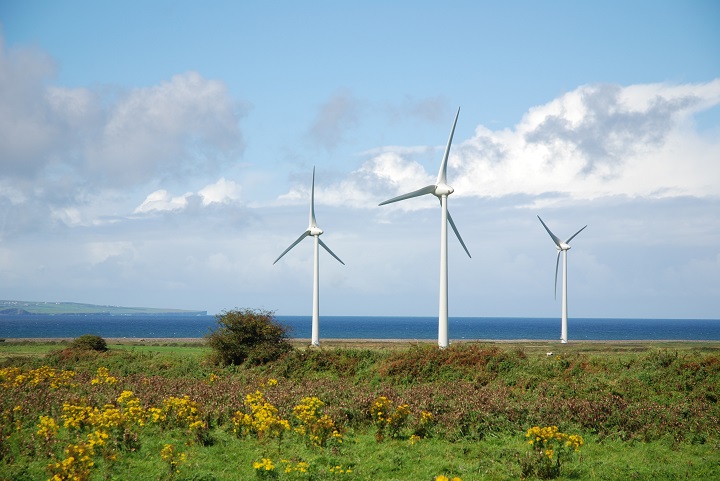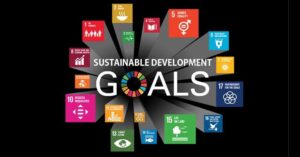Hydrogen and renewable energy technologies, global leadership in green energy, and the role of the SDGs as a political roadmap with Professor Ravindranathan Thampi, School of Chemical and Bioprocess Engineering.

Professor Ravindranathan Thampi
SFI Airtricity Professor of Solar Energy Engineering, UCD School of Chemical and Bioprocess Engineering
UCD Profile
Q: You work a lot on renewable energy technologies, tell us about your main interests
A: My general interest is in the broad area of renewable and low carbon energy technology. My main interest is in solar, and particularly, the production of clean hydrogen using renewable energy sources. I should elaborate why I insist on clean hydrogen. Hydrogen is considered to be a clean fuel, because hydrogen produces water as a product of combustion or any reaction releasing energy. But that’s actually only half of the story. Today, the industrial hydrogen, 95%+ maybe up to even 97% of the market, is more or less coming from hydrocarbons, i.e., fossil fuel based feedstock and reactions. Most people do not understand that. This is why in every conversation or talk on hydrogen I specify that it should be clean renewable hydrogen. Otherwise, it is not meaningful!
So how can we produce clean hydrogen? We have to produce hydrogen from water, not from hydrocarbon fuels. Producing hydrogen from water or from fossil fuels, whichever you use, it is very energy intensive. You need to find energy which is renewable for driving that process. If you want to have clean hydrogen from a clean source like water, then the energy input has to be also clean, i.e., solar, wind or any other electricity produced without relying on fossil fuels. It is only clean when made in this manner.
Q: What barriers exist to uptake of hydrogen as an energy source?
A: For producing hydrogen, using renewable energy sources and an electrolyser or directly splitting water in situ using semiconductors and photoelectrocatalysts without first generating electricity, the main issue is the cost involved. For example, hydrogen produced today from fossil fuels is something like less than a Euro per kilogram. Hydrogen produced from renewable sources on the other hand can vary anywhere between six to fourteen Euro per kilogram. Let us say six to seven Euro per kilogram is a reasonable price to expect as of now. This will have to be brought down further to less than four Euros in order to make the clean hydrogen energy dream a reality, because after all, our society has to pay for it as affordability matters. We are all happy to pay a bit more money, but we cannot spend ten times the price we pay for energy now. We need to therefore develop newer technologies and highly efficient ways of handling it.
The other issue with hydrogen is the lack of infrastructure to supply and dispense it across the nation states. Let us take a simple case where you are travelling from Dublin to Northern Ireland or to Kerry in a hydrogen fuel cell powered vehicle. You will have to refuel the vehicle on your way, which means during the trip you need the necessary infrastructure to supply you with clean hydrogen. This requires huge capital investment, which will have to be amortised within let’s say twenty five to thirty years. For that you need a huge amount of capital to be earmarked as fresh investments. Who is going to pay for or fund it? The consumer is going to pay at the end of the day. Are we ready for that kind financial outlays? How can you really increase the use of hydrogen without funding the infrastructure creation? In the European Commission, in general discussions and meetings, I always stress that we should look at public transport, first. Public transport always covers a set trajectory, it goes through designated places and comes back to the same depot. To service public transport, you don’t have to have the same infrastructure laid out throughout the country for people to stop at will and refuel, like with cars. We should start where we find the least number of hurdles like cost, and public transport is a good domain to start with.

“How can you really increase the use of hydrogen without funding the infrastructure creation? In the European Commission, in general discussions and meetings, I always stress that we should look at public transport, first. Public transport always covers a set trajectory, it goes through designated places and comes back to the same depot […] We should start where we find the least number of hurdles like cost, and public transport is a good domain to start with”
– Prof. Ravi Thampi
Q: Which other renewable energies do you see as having high potential to meet global needs?
The technology with the most potential is of course solar, because it is by far the most abundant, and practically is an unlimited energy resource. To give you numbers, for example, ten to the power of five terawatts is the influx of solar energy at the earth’s surface. This is the availability of solar energy, which we can take as a potentially indicative technical value. In comparison, wind is just about fourteen terawatts. Most often people working on wind do not realise that the wind energy is also originating from solar activities on this planet; the temperature differences, the climatic differences, the local weather differences, etc. are the responsible factors influencing the wind speed and direction. The root cause of all the weather variations is of course the solar energy influx on this planet. Thus, the sun is the number one highest potential clean energy source for mankind.
If you look at other technical values, biomass is approximately less than one half of wind, around six to seven terawatts. You have to remember that you have to use or exploit biomass very carefully, because biomass is also a source of nutrition and is the vital food source for people and animals. Obviously, if you depend too much on biomass for energy, then you are likely to encroach into agricultural lands in a significant manner, you also impact the soil with fertilisers and phytochemicals, and divert the use of clean water from our food chain. Water is already a scarce resource in many places. We cannot really produce biomass for energy purposes beyond a point without effecting the food supply, especially in poorer countries, especially in Africa. People have calculated in the past, for example, when people produced maize and grain for producing bio-alcohol for running vehicles and how that impacted the price of a loaf of bread. That’s a good way of illustrating the side effects of relying too much on these other renewable resources linked to food, water and land utilisation.
Q: Are there particular renewable energy types that are most suitable for Ireland?
A: Good question. I’m not a wind energy man, I’m more into solar. Nevertheless, if you ask me locally for Ireland, I would say wind, it’s abundant here. However another argument might be that if you look at the map, the latitude of certain parts of Germany is not that different to the southern tip of Ireland. But then Germany is not an island, the clouds are not as frequent as in Ireland. So it’s not the latitude that matters, but rather the insulation. If you compare Ireland to countries like Greece, Portugal, Spain, we see that it is easier to get faster returns in those countries on investments in solar panels than in Ireland. We need to look at the economic aspects as well, when promoting renewable energy technologies. I like hydrogen, I like solar cells, but economics has the final say in whether a technology gets accepted in a society. Of course, the surplus wind power can be stored in the form of hydrogen or as electrical power in batteries.

Q: What about storage of electricity, is battery technology a barrier?
A: The answer is complex. First of all batteries are just only one of the ways to store, it is not the only method. For example, you can pump water up the mountain and store it in a dam. In France they produce about two thirds or more of their electricity from nuclear plants. In that, you cannot vary the production depending on the demand, it is steady all the time, whether you can use it or not, the power is produced continuously. The price of electricity in the night is therefore very cheap due to low demand. Switzerland buys this cheap power, and simply pumps water upstream to the dams at night. When you pump this water downstream through a hydro turbine during the next day during peak demand, then you can produce back electricity and recover around 70-80% of the net energy purchased at a low price. It then allows to sell that power back to the grid at a higher price and at the same time meet the increased demand in an ecological and sustainable manner.
There are also several types of batteries. Some can charge and discharge only a small amount of power, then there are also batteries that can charge and discharge huge amounts of power. There are also the flow batteries, which can store and discharge a lot of power through a simple process. There are also several mechanical methods to store electricity. Even high temperature batteries are being tested these days. These are all being studied as potential options, but there are difficulties with all of them depending on how they are charged and discharged, the number of charge-discharge cycles, availability of raw materials in a sustainable and equitable manner, etc. One that we always rely on now is the lithium battery. Of course, you need lithium, do we have sufficient lithium to cater to all our lithium storage requirements? Very difficult to get that if we follow the best practices in sustainability criteria. If you want to extract the maximum possible amounts of lithium from various mines etc, there will also be a lot of environmental pollution and damage to expect from it. All sorts of other issue with the recycling of these materials also exist. In brief, we need multiple methods to store surplus power and discharge it for use in an intelligent manner. These are the new technological problems for us to solve urgently!
Basically if you want to really make good progress in energy storage through batteries, you need to have batteries made out of earth abundant materials like sodium, for example. If you look at the periodic table you see that lithium, sodium and potassium, they all fall in the same group. If you skip lithium, the next candidate Is sodium. Can we make sodium or sodium-sulphur batteries? Yes, but they are technologically not mature enough to be cost effective. I am pretty sure they will mature in the near term and that will make a huge difference. Otherwise hydrogen is a good way of storage, though that opens up other challenging questions of storage and supply/distribution infrastructure. You can store it in pressurised canisters, as liquid, and you need a lot of energy consumption for that process and it’s expensive. Energy storage is a very difficult topic.
Q: What kind of broader systemic or social change need to happen to move society to sustainable energy?
A: I cover this in my classes. It’s much about policy matters. A party coming into power and insisting on carbon reduction, and the government then saying this has to be done. This is a top down approach. But to be successful it has to be a merging of two forces. It should first be a bottom-up demand, guided by a top-down policy approach. People want to be greener, then the government or political parties should be able to satisfy that demand and take a path where the ups and downs and pros and cons are carefully considered, thereafter taking a solid committed approach over a long term.
I can see here a few role models. Japan is probably the number one in this case. The population wants clean energy, they are anti-nuclear because of historical reasons, they don’t really want to bring in more and more carbon containing fuels from other countries. Japanese people are generally very progressive, highly civilised and are technologically advanced. It is a very structured and designed society. Japan is probably number one as a role model in this! Their top down approach is meant for a very long term. They used to have a funding scheme called Moonlight project fund. These project schemes were for twenty years compared to European projects of three-seven years. In Europe, you get three million, and they say bring me something after three years. Already after one and a half years the funding agency will push you, where are your patents, do you find any investors? Japanese had a policy and a funding structure over twenty years. It’s a long term approach. That gives the required progress.
Within Europe the Nordic countries like Sweden are also role models. Swedish people are highly committed to renewable energy, fortunately by grace of nature they have a lot of clean resources, pristine water and so on. The other role models in Europe are Germany and Switzerland. In Germany, for example, the people are extremely green conscious. You talk to a reasonably educated guy, working in a small enterprise, they are committed to it. That kind of German approach is completely lacking in Ireland. The approach of the population and what they demand in Ireland and Germany are entirely different. I’m not talking about politics, I’m talking about the general culture.
“The ultimate question is how do we increase our ability to conserve energy? That has to come from reducing wastage. How can we do that? […] The problem is the taxation, tax structure, subsidies, and all that has to be lined up for good. The people have to demand energy conservation and then the government has to bring in the right policies which will help to create the right approach.”
– Prof Ravi Thampi
Q: Perhaps also the historical reliance on peat as an energy source. What other challenges do you see in Ireland?
A: Yes, peat is one of the most polluting sources of energy. It’s also affordability and the nature of taxation. Switzerland had in the late nineties or 2000s something called a 2 KW Society movement. In a nutshell, a 2 KW Society consider how the Swiss lived in the sixties and seventies comfortably on an average per capita consumption of 2kw of pollutive energy. They aimed that anything consumed above that has to come from renewables, non-pollutive sources. The Swiss government was looking more towards known technologies and known commercial products to increase the conservation of energy, improving building standards, roof insulation, triple glazed windows, advanced room heating concepts, etc.
In contrast in Ireland, although we have a large production of wind in Ireland, the situation in home heating, home energy in Ireland is pathetic. We are nowhere near the European norms or directives. The ultimate question is how do we increase our ability to conserve energy? That has to come from reducing wastage. How can we do that? For example, most apartments and houses in Dublin, is leaky at the window, the door and everywhere else. I don’t know if the walls are insulated adequately. The energy loss is so huge. What Swiss, Germans, Swedes, Austrians have done is to make your habitat more energy efficient – refurbished by better insulation, design to trap sunlight, etc. It’s a bit expensive. But you don’t require new technologies to achieve most of it as there are products in the market already to do that, and it also creates new jobs. The problem is the taxation, tax structure, subsidies, and all that has to be lined up for good. The people have to demand energy conservation and then the government has to bring in the right policies which will help to create the right approach.
Q: Where do you see at universities role in the development of new technologies?
A: The technology generated in the universities and eventually maturing into a technological product takes a long time. Nevertheless, Ireland is one of the most successful countries in terms of its start-up ecosystem, and also the small enterprises in new technologies coming from universities. Ireland is well positioned there. But if you look into the energy scene, the innovation that we see in Ireland in terms of renewable energy is mostly wind energy. That credit all goes to one company that went into wind generation for the first time and they had such a success story. Then, everybody went into it, too. It is good!
If you look at solar, I know that a lot of people have land, and farmers are waiting for policy changes so that they can install solar panels and export this renewable electricity to the grid and make money, but then nothing is happening sufficiently fast. There are a lot of lobbies and interests and discussion, but not much is really happening on the ground as we would like to see. We need to align our actions and our targets.
Let us talk about utility companies and the public posturing of these utility companies all over the world, not just in Ireland. When they talk to the public they talk elaborately about the future of green, the future of renewable energy and all the welcoming approach to new ideas to flourish, they are ready, and so on. But when you go to them with a new technology they will say, but coal is very cheap and even if I put all the carbon tax on top, the renewable energy technologies are nowhere near. In other words, on the office table and outside, you hear two different stories. This is not only in Ireland. Utility companies everywhere are very conservative. They say one thing outside but when it comes to new ideas, they don’t want to take any risk. So how do I get new ideas funded? New ideas crystallised? I have to go to California, probably, for VCs. Not in Europe. Of course, I know a few encouraging exceptions to this general attitude of utility companies.
I’m pretty sure that eight ideas out of ten from a university fails in the market place. The question now is how can you create an ecosystem where these cash rich companies really shell out a bit of their money and take the required risk. That risk taking is completely absent in Europe, not just in Ireland only. When something happens in north America, then we are all happy to import that technology and talk about it, and then do a peripheral service to it and say that we are the masters of it. But rather the same idea evolving here, nobody wants to take the risk. That is unfortunately the problem when you talk about partnerships between university and industry. Energy related technologies, energy generation or storage innovation are all very capital intensive.
“At the end of the day maximisation of profit and productivity is no more the mantra for success. That’s an old twentieth century idea. In that aspect I should say the UN Sustainable Development Goals are an effort in the right direction, and it shows how a political roadmap for governments to think and act more locally, but with a global view.”
– Prof Ravi Thampi
Q: What kind of disciplines to you work with?
In my work I do a lot of catalysis, material science, nano and mesoporous materials. I have worked with biomass energy, too. I used to be very active in fuel cells in the past. These are my main activities. Lately I am concentrating more on, for example, in teaching and lecturing on, the importance of sustainability, whether it’s energy, agriculture, or even the socio-economic aspects pertaining to the use of energy and materials. Many academic scientists tend to think narrowly within their core study subject and they think my product or my method or invention is going to solve all the problems of mankind and that we all know is a very short sighted approach. To make a technology successful it has to go through a number of really hard-to-solve hurdles. Often the one that pops up and kills you, your entire enthusiasm and all your creativity, is the economic viability of the practical approach. Unfortunately, most scientists don’t consider economic factors in their projections at an early stage.
Then the societal acceptance matters, too. We need to consider all that. Will it deprive some people, is it going to pollute, does it create more waste? At the end of the day maximisation of profit and productivity is no more the mantra for success. That’s an old twentieth century idea. In that aspect I should say the UN Sustainable Development Goals are an effort in the right direction, and it shows how a political roadmap for governments to think and act more locally, but with a global view. In other words, we need to have a global view about our future generations. The SDGs are a very good framework that was missing all these years. We need to act locally but with a global mindset. We need sustainable use and management of our resources. Energy usage is just one big tranche of the whole pie but it’s still not the whole picture. Materials management is another equally important piece to consider seriously!

